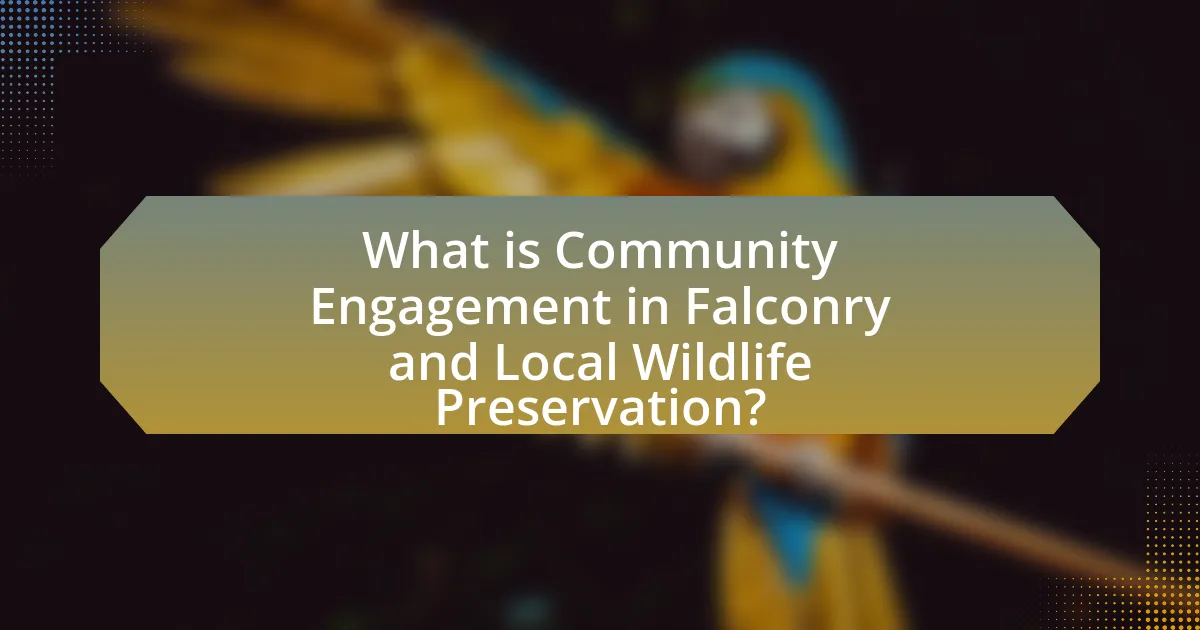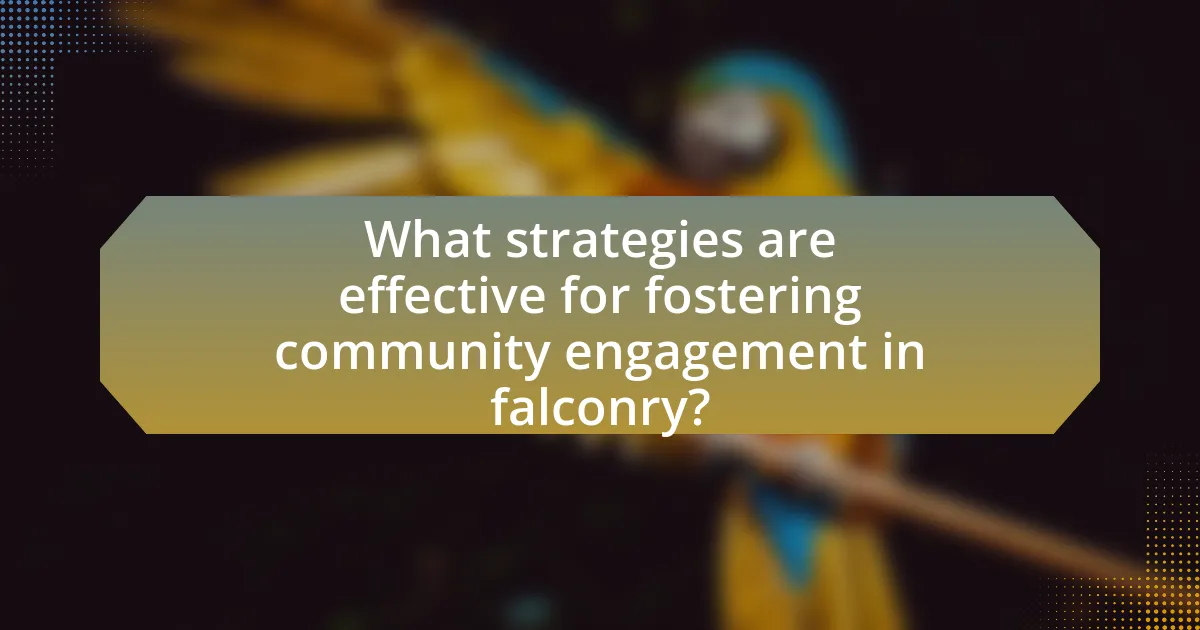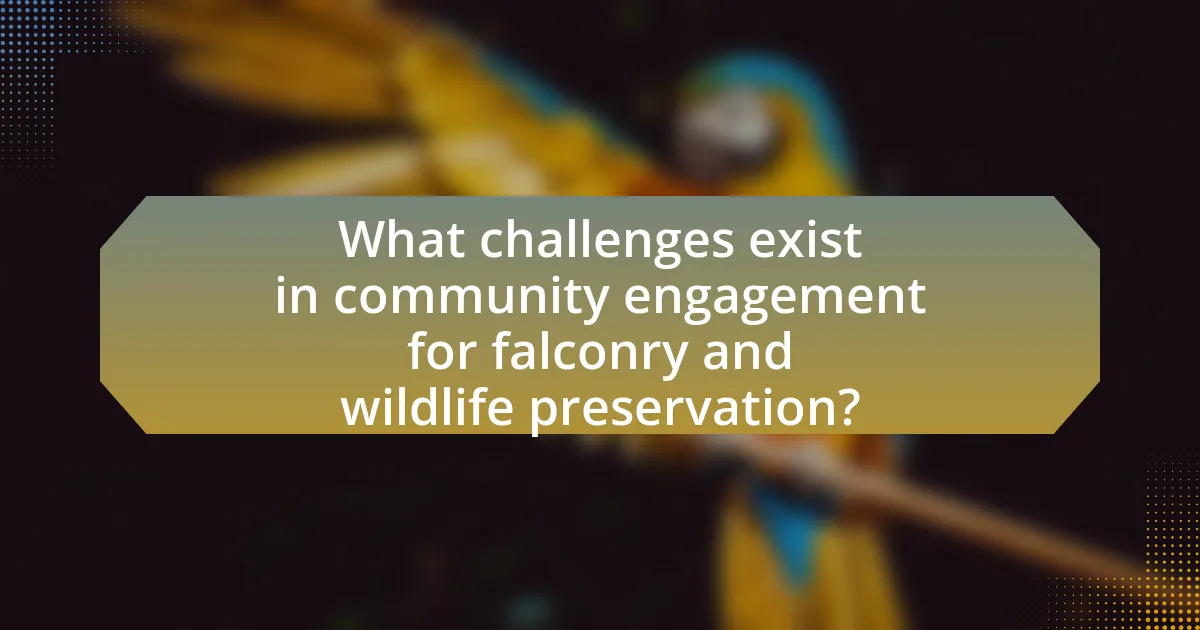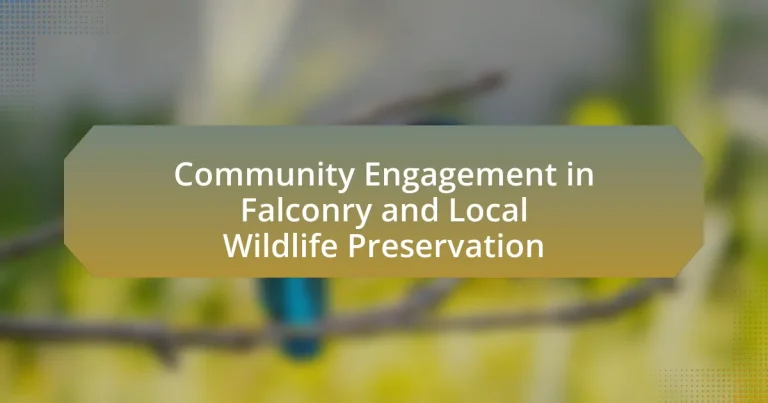Community engagement in falconry and local wildlife preservation is a collaborative effort that involves individuals and organizations working together to promote sustainable falconry practices while protecting local ecosystems. This article explores the significance of community involvement in enhancing falconry techniques, preserving traditional practices, and fostering cultural heritage. It highlights the roles of local communities in wildlife management, the ecological benefits of preserving local wildlife, and effective strategies for fostering engagement through educational programs and partnerships. Additionally, the article addresses challenges faced in community participation and offers practical steps for individuals to contribute to falconry and wildlife conservation efforts.
What is Community Engagement in Falconry and Local Wildlife Preservation?

Community engagement in falconry and local wildlife preservation involves active participation of individuals and groups in conservation efforts that promote the sustainable practice of falconry while protecting local ecosystems. This engagement often includes educational programs, workshops, and community events that raise awareness about the importance of raptors and their habitats. For instance, organizations like the North American Falconers Association work to foster relationships between falconers and conservationists, emphasizing the role of falconry in wildlife management and habitat preservation. Such initiatives not only enhance public understanding of wildlife conservation but also encourage responsible practices among falconers, thereby contributing to the overall health of local wildlife populations.
How does community engagement enhance falconry practices?
Community engagement enhances falconry practices by fostering collaboration and knowledge sharing among practitioners and the public. This interaction leads to improved techniques, conservation efforts, and a greater understanding of raptor ecology. For instance, community workshops and events allow falconers to exchange best practices and innovations, which can enhance training methods and bird care. Additionally, engaging local communities in conservation initiatives helps raise awareness about the importance of raptors and their habitats, ultimately supporting sustainable falconry practices. Studies have shown that community involvement in wildlife management leads to more effective conservation outcomes, as seen in various programs that integrate local knowledge with scientific research.
What roles do local communities play in falconry?
Local communities play a crucial role in falconry by preserving traditional practices, promoting conservation efforts, and fostering cultural heritage. These communities often engage in training and mentoring new falconers, ensuring the transmission of knowledge and skills essential for the sport. Additionally, local groups frequently collaborate with wildlife organizations to protect habitats and support sustainable practices that benefit both falconry and local ecosystems. For instance, community-led initiatives can lead to the establishment of protected areas that support raptor populations, demonstrating the interconnectedness of falconry and wildlife preservation.
How does falconry contribute to wildlife preservation efforts?
Falconry contributes to wildlife preservation efforts by fostering a deeper understanding of raptor species and their ecosystems among practitioners and the public. Through training and caring for birds of prey, falconers promote conservation awareness and engage in habitat protection initiatives. For instance, many falconers participate in breeding programs for endangered species, helping to increase their populations and genetic diversity. Additionally, falconry often involves educational outreach, where falconers share knowledge about the importance of biodiversity and the role of raptors in the ecosystem, thereby inspiring community involvement in conservation efforts.
Why is local wildlife preservation important in the context of falconry?
Local wildlife preservation is crucial in the context of falconry because it ensures the sustainability of the ecosystems that support both raptors and their prey. Healthy wildlife populations provide the necessary food sources for falcons, which in turn helps maintain the balance of local ecosystems. For instance, the decline of small mammal populations can directly impact the survival of falcons, as they rely on these animals for nourishment. Furthermore, preserving local habitats protects the breeding grounds and nesting sites essential for raptor reproduction, thereby supporting the overall health of falcon populations.
What are the ecological benefits of preserving local wildlife?
Preserving local wildlife provides essential ecological benefits, including biodiversity maintenance, ecosystem stability, and natural resource sustainability. Biodiversity is crucial as it enhances ecosystem resilience, allowing environments to recover from disturbances and adapt to changes. For instance, diverse species contribute to various ecological functions, such as pollination, nutrient cycling, and pest control, which are vital for healthy ecosystems. Additionally, local wildlife plays a significant role in maintaining food webs and habitat structures, ensuring that ecosystems remain balanced and functional. Research indicates that areas with higher biodiversity are more productive and better at providing ecosystem services, which are essential for human well-being and environmental health.
How does falconry promote awareness of local wildlife issues?
Falconry promotes awareness of local wildlife issues by engaging practitioners and the public in the conservation of raptor species and their habitats. Through hands-on experiences, falconers educate communities about the ecological roles of birds of prey, fostering a deeper understanding of local ecosystems. For instance, falconry programs often include workshops and demonstrations that highlight the importance of preserving natural habitats, which directly impacts local wildlife populations. Studies have shown that such educational initiatives can lead to increased community involvement in conservation efforts, as participants become more aware of the challenges faced by local wildlife, such as habitat loss and pollution.
What strategies are effective for fostering community engagement in falconry?

Effective strategies for fostering community engagement in falconry include organizing educational workshops, promoting local falconry events, and collaborating with conservation organizations. Educational workshops provide hands-on experiences that enhance understanding of falconry practices and the importance of raptor conservation. Local events, such as falconry demonstrations and competitions, create opportunities for community members to interact with falconers and learn about the sport. Collaborating with conservation organizations helps to align falconry with broader wildlife preservation efforts, thereby attracting individuals who are passionate about environmental stewardship. These strategies have been shown to increase community interest and participation in falconry, as evidenced by increased attendance at events and higher enrollment in educational programs.
How can educational programs enhance community involvement?
Educational programs can enhance community involvement by providing knowledge and skills that empower individuals to participate actively in local initiatives. These programs often include workshops, seminars, and hands-on activities that educate participants about falconry and wildlife preservation, fostering a sense of responsibility and connection to local ecosystems. For instance, studies have shown that community-based educational initiatives can increase volunteer participation by up to 50%, as individuals feel more informed and motivated to contribute to conservation efforts. By engaging community members through targeted educational content, these programs create a collaborative environment where local wildlife preservation becomes a shared goal.
What types of educational initiatives are most impactful?
Educational initiatives that are most impactful include hands-on workshops, community outreach programs, and collaborative conservation projects. These initiatives engage participants directly, fostering a deeper understanding of local wildlife and the importance of preservation efforts. For instance, studies have shown that experiential learning, such as falconry demonstrations, significantly enhances knowledge retention and appreciation for wildlife conservation. Additionally, community-based programs that involve local stakeholders in conservation efforts have been proven to increase community investment and participation, leading to more sustainable outcomes.
How can workshops and demonstrations facilitate learning?
Workshops and demonstrations facilitate learning by providing hands-on experiences that enhance understanding and retention of knowledge. These interactive formats allow participants to engage directly with the subject matter, such as falconry techniques or wildlife preservation practices, fostering a deeper connection to the content. Research indicates that experiential learning, which is often employed in workshops, can improve knowledge retention by up to 75% compared to traditional lecture-based methods. This active participation encourages critical thinking and problem-solving skills, making the learning process more effective and memorable.
What role do partnerships play in community engagement?
Partnerships play a crucial role in community engagement by fostering collaboration among various stakeholders, including local organizations, government agencies, and community members. These collaborations enhance resource sharing, increase outreach efforts, and amplify the impact of community initiatives. For instance, partnerships in falconry and local wildlife preservation can lead to joint educational programs, conservation projects, and community events that raise awareness about wildlife protection. Research indicates that community engagement efforts are more successful when multiple entities work together, as evidenced by the increased participation rates and improved outcomes in initiatives that involve partnerships.
How can local organizations collaborate with falconers?
Local organizations can collaborate with falconers by organizing joint educational programs and conservation initiatives that promote awareness of local wildlife and falconry practices. Such collaborations can include workshops, community events, and school programs where falconers demonstrate their skills and share knowledge about raptor conservation. For instance, partnerships can lead to the development of local wildlife preservation projects that utilize falconry techniques to manage pest populations, thereby benefiting both the community and the ecosystem. This approach not only enhances community engagement but also fosters a deeper understanding of the ecological role of birds of prey, supported by studies showing that educational outreach significantly increases public interest in wildlife conservation.
What benefits arise from community partnerships in wildlife preservation?
Community partnerships in wildlife preservation enhance conservation efforts through increased local engagement and resource sharing. These collaborations foster a sense of ownership among community members, leading to more effective protection of local wildlife habitats. For instance, studies have shown that communities involved in conservation initiatives are more likely to report increases in biodiversity and habitat restoration. Additionally, partnerships often provide access to funding and expertise, which can amplify the impact of preservation activities. Research indicates that areas with strong community involvement see a 30% improvement in conservation outcomes compared to those without such partnerships.
What challenges exist in community engagement for falconry and wildlife preservation?

Challenges in community engagement for falconry and wildlife preservation include a lack of awareness, cultural misconceptions, and limited resources. Many communities are unaware of the ecological benefits of falconry, which can lead to resistance against conservation efforts. Cultural misconceptions about falconry often portray it negatively, hindering community support. Additionally, limited financial and educational resources restrict the ability to conduct outreach programs, making it difficult to foster meaningful engagement. For instance, a study by the International Association for Falconry and Conservation of Birds of Prey highlights that educational initiatives are crucial for overcoming these barriers, yet many organizations struggle to secure funding for such programs.
What barriers hinder effective community participation?
Barriers that hinder effective community participation include lack of awareness, insufficient resources, and social or cultural divides. Lack of awareness prevents individuals from understanding the importance of their involvement in community initiatives, particularly in specialized areas like falconry and wildlife preservation. Insufficient resources, such as funding and access to information, limit the ability of communities to engage effectively in these activities. Additionally, social or cultural divides can create an environment where certain groups feel excluded or marginalized, reducing overall participation. These barriers collectively impede the ability of communities to collaborate and contribute to local wildlife preservation efforts.
How can misconceptions about falconry affect community engagement?
Misconceptions about falconry can significantly hinder community engagement by fostering negative perceptions and misunderstandings about the practice. When individuals believe falconry is solely about hunting or harming wildlife, they may oppose local initiatives aimed at wildlife preservation that involve falconers. For instance, studies have shown that communities with a lack of understanding about falconry often resist collaborative conservation efforts, as they view falconers as threats to local ecosystems rather than allies in wildlife management. This resistance can lead to decreased participation in community events and educational programs that promote the benefits of falconry in conservation, ultimately undermining efforts to engage the public in wildlife preservation initiatives.
What logistical challenges do communities face in wildlife preservation efforts?
Communities face several logistical challenges in wildlife preservation efforts, including limited funding, inadequate infrastructure, and insufficient coordination among stakeholders. Limited funding restricts the ability to implement effective conservation programs, as many initiatives require financial resources for research, habitat restoration, and community education. Inadequate infrastructure, such as lack of access to remote areas where wildlife habitats are located, hampers monitoring and protection efforts. Additionally, insufficient coordination among various stakeholders, including government agencies, non-profits, and local communities, leads to fragmented efforts that can undermine the overall effectiveness of wildlife preservation initiatives. These challenges collectively hinder the ability of communities to engage in and sustain successful wildlife conservation efforts.
How can communities overcome these challenges?
Communities can overcome challenges in falconry and local wildlife preservation by fostering collaboration among stakeholders, including local governments, conservation organizations, and community members. This collaboration can lead to the development of educational programs that raise awareness about the importance of wildlife preservation and the role of falconry in sustainable practices. For instance, successful initiatives have been implemented in various regions where community workshops and training sessions have increased participation in conservation efforts, resulting in improved local biodiversity. Additionally, establishing clear regulations and support systems for falconers can enhance responsible practices, ensuring that both falconry and wildlife preservation coexist effectively.
What strategies can be implemented to improve engagement?
To improve engagement in community involvement with falconry and local wildlife preservation, strategies such as organizing interactive workshops, creating social media campaigns, and establishing partnerships with local schools can be implemented. Interactive workshops allow participants to experience falconry firsthand, fostering a deeper connection to wildlife. Social media campaigns can raise awareness and share success stories, reaching a broader audience and encouraging participation. Partnerships with local schools can integrate wildlife education into curricula, engaging younger generations and promoting long-term interest in preservation efforts. These strategies have been shown to enhance community involvement and awareness in environmental initiatives.
How can success stories inspire further community involvement?
Success stories can inspire further community involvement by demonstrating tangible outcomes and fostering a sense of shared achievement. When individuals or groups witness the positive impact of successful initiatives, such as increased wildlife populations or enhanced community cohesion through falconry programs, they are more likely to engage in similar efforts. Research indicates that storytelling can significantly enhance community participation; for instance, a study published in the Journal of Community Psychology found that narratives of success can motivate individuals to contribute to community projects, as they see the potential for their involvement to lead to meaningful change. This connection between success and motivation reinforces the idea that shared stories can catalyze further action within the community.
What are best practices for successful community engagement in falconry?
Best practices for successful community engagement in falconry include fostering education, building partnerships, and promoting conservation efforts. Educating the community about falconry’s history, techniques, and ecological significance enhances understanding and appreciation. Collaborating with local wildlife organizations and schools can create programs that involve community members in hands-on experiences, such as workshops or demonstrations. Additionally, promoting conservation initiatives that highlight the role of falconry in wildlife preservation can strengthen community ties and encourage active participation. These practices are supported by studies indicating that community involvement in wildlife management leads to increased awareness and support for conservation efforts.
How can ongoing communication enhance community relationships?
Ongoing communication enhances community relationships by fostering trust and collaboration among members. Regular dialogue allows community members to share concerns, ideas, and resources, which strengthens social bonds and encourages collective problem-solving. For instance, studies have shown that communities with active communication networks experience higher levels of civic engagement and participation in local initiatives, leading to more effective conservation efforts in wildlife preservation. This is evidenced by the success of community-led projects in falconry, where ongoing discussions about best practices and shared goals have resulted in increased awareness and support for local wildlife conservation efforts.
What role does feedback play in improving engagement initiatives?
Feedback is essential for enhancing engagement initiatives as it provides insights into participant experiences and preferences. By collecting and analyzing feedback, organizations can identify strengths and weaknesses in their initiatives, allowing for targeted improvements. For instance, a study by the International Association for Public Participation found that incorporating participant feedback led to a 30% increase in community satisfaction with engagement efforts. This demonstrates that feedback not only informs adjustments but also fosters a sense of ownership among participants, ultimately leading to more effective and sustainable engagement initiatives.
What practical steps can individuals take to engage in falconry and wildlife preservation?
Individuals can engage in falconry and wildlife preservation by obtaining the necessary permits and training through accredited falconry programs. These programs often provide hands-on experience with birds of prey, emphasizing responsible handling and care. Additionally, individuals can participate in local wildlife conservation efforts, such as habitat restoration projects or educational outreach initiatives, which help raise awareness about the importance of preserving natural ecosystems. Joining organizations dedicated to falconry and wildlife preservation, such as the North American Falconers Association, can also provide resources and networking opportunities to further support these efforts.


